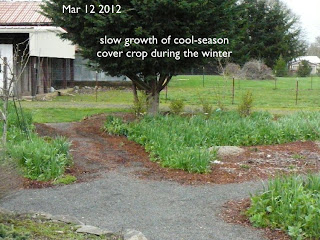We transformed about 1/4 of our 12,000-square-foot lawn in early spring of 2011 (see separate post). This post looks at its progress in 2012.
In early June 2011, the forest garden looked like this:
Small plants with 3-4” of bark mulch spread everywhere.
The bark mulch covers interlayered straw, compost, newspaper and cardboard; the goal of this sheet (or “lasagna”) mulch project was to kill the lawn and encourage worms and other helpful life forms to start producing a healthy humus layer….grass roots produce diddly.
I decided to plant a cool-season cover crop—oats, vetch, bell beans, etc. I hoped these plants would (a) grow (slowly) during the winter and spring, (b) break up the previously grass-bound soil with their roots, and (c) provide biomass to the developing humus layer when they died.
In late October 2011, I raked the bark mulch to the side, scored the soil with the rake,
sowed the cover-crop seed by hand, and then lightly raked to cover the seeds (most of them, anyway) with a thin layer of soil. I left the bark mulch “dikes” where they were, for the time being.
By mid-November, the cover crop was a few inches tall—not a jungle, but at least it had a small head-start on winter.
Lesson learned for 2012: Plant the cover crop earlier.
Throughout the winter, this batch of hardy plants continued to grow slowly. By mid-March, it was over a foot tall.
Then came the warmer days of early spring, and the stuff shot up. Two feet high by mid-April:
I scythed it down and left in place to decompose and feed the soil. Most farmers who plant a cover crop till it under to minimize losses to the atmosphere, but not here—any tiller would compact the forest-like soil I’m trying to develop.
Anyway, the stuff kept growing—about two feet in a month! I scythed it down again in late May,
and planted buckwheat, which thrives in the warmer months. The buckwheat grew vigorously through July, and I scythed it down twice. It went to seed in early August, and partially self-seeded a second late-summer crop. However, I didn’t water it much in late August and September, so it faded a bit.
Here is a series of pictures taken from the same spot on our back deck at different times of 2012:
In the first week of October, I sowed another batch of cool-season cover-crop seed. Two months later, it’s only several inches high, but I’m confident that it will be at least as vigorous as last year’s. Meanwhile, the soil has become much lighter, thicker, and healthier (worms!) than in early 2011, so it’s well on its way to supporting a forest garden.









No comments:
Post a Comment